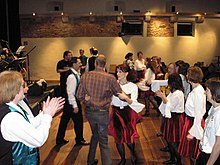
Back Джыга BE-X-OLD Slide (dansa) Catalan Jig German Τζιγκ Greek Slide (danza) Spanish جیگ Persian Jig French Port (ceol) Irish Slide jig Galician Ջիգա Armenian
This article needs additional citations for verification. (January 2023) |

The jig (Irish: port, Scottish Gaelic: port-cruinn) is a form of lively folk dance in compound metre, as well as the accompanying dance tune. It first gained popularity in 16th-century England, Ireland, Scotland, and other parts of the British Isles,[1][2] and was adopted on mainland Europe where it eventually became the final movement of the mature Baroque dance suite (the French gigue; Italian and Spanish giga).[3] Today it is most associated with Irish dance music, Scottish country dance and the Métis people in Canada.[4] Jigs were originally in quadruple compound metre, (e.g., 12
8 time), but have been adapted to a variety of time signatures, by which they are often classified into groups, including double jigs (6
8), slip jigs (9
8) and single jigs (12
8).
- ^ "Anglo-Irish Music in the Sixteenth Century". Retrieved 11 January 2023.
- ^ "The jig dance tradition: five centuries old and still counting | Music Tales". musictales.club. Retrieved 4 March 2021.
- ^ Randel, Don Michael, ed. (2003). The Harvard dictionary of music (4th ed.). Cambridge, MA: Belknap Press of Harvard University Press. pp. 421, 430. ISBN 9780674011632.
- ^ Driscoll, Michael; Hamilton, Meredith; Coons, Marie (May 2003). A Child's Introduction to Poetry. New York: Black Dog & Leventhal Publishers. p. 12. ISBN 1-57912-282-5.
© MMXXIII Rich X Search. We shall prevail. All rights reserved. Rich X Search